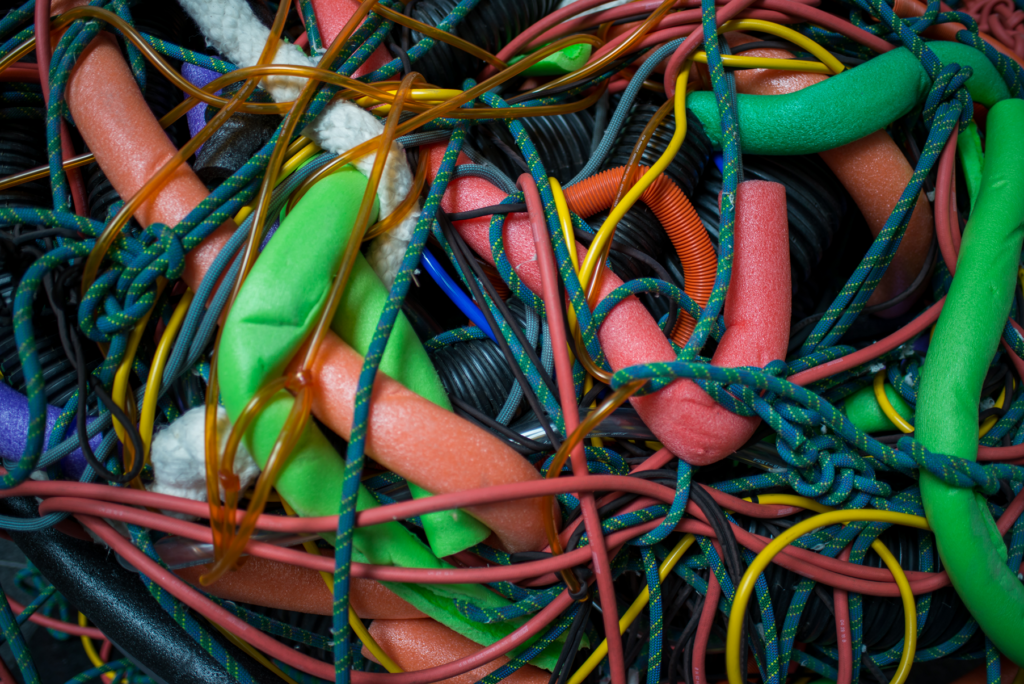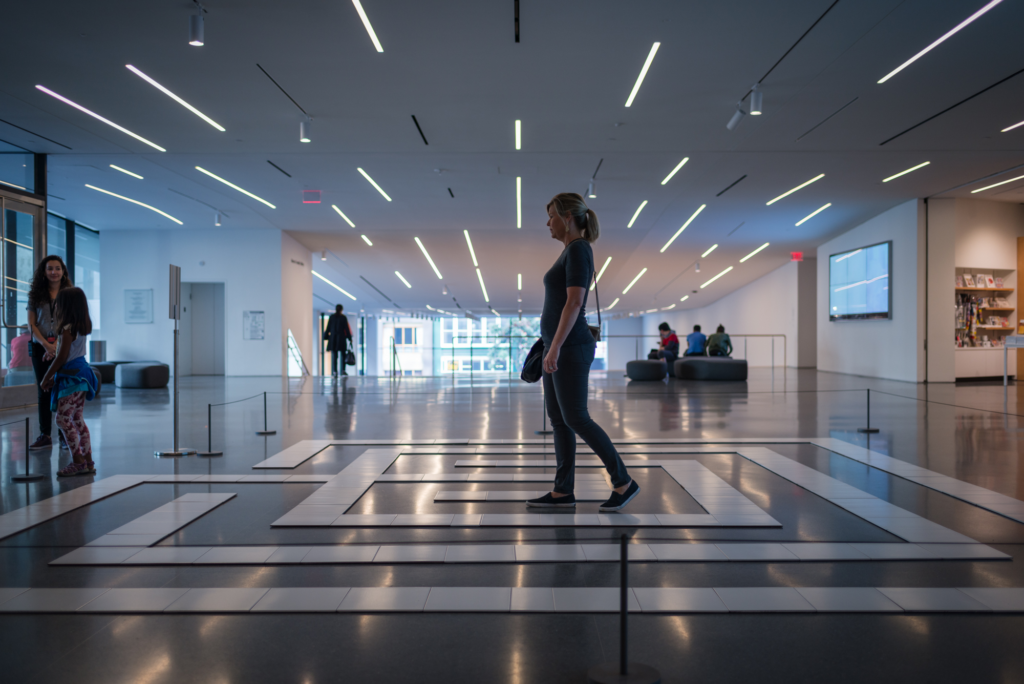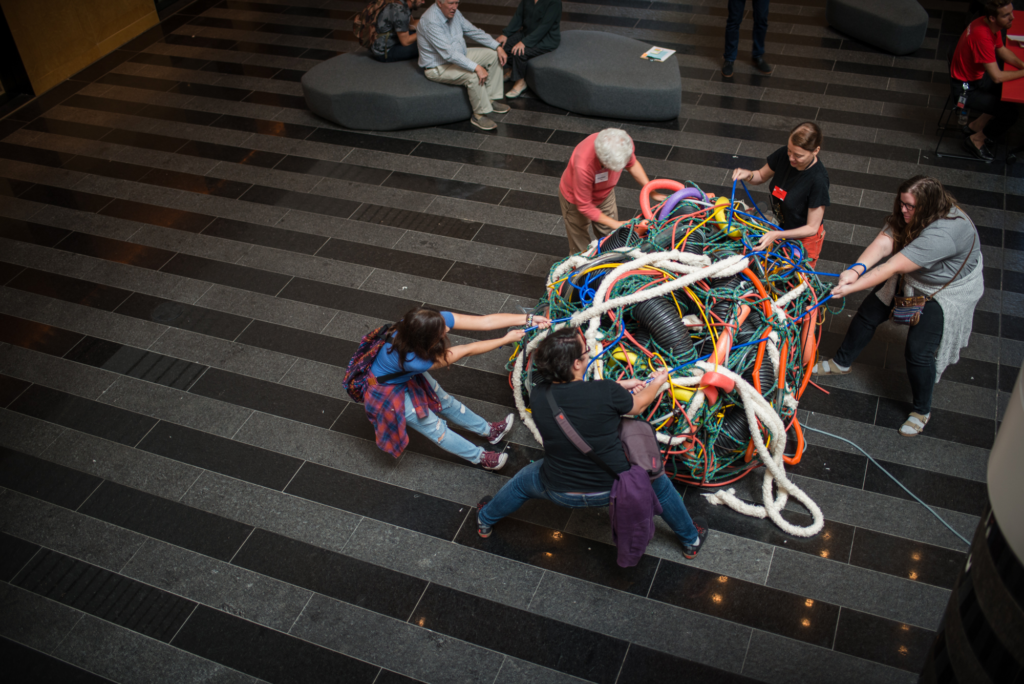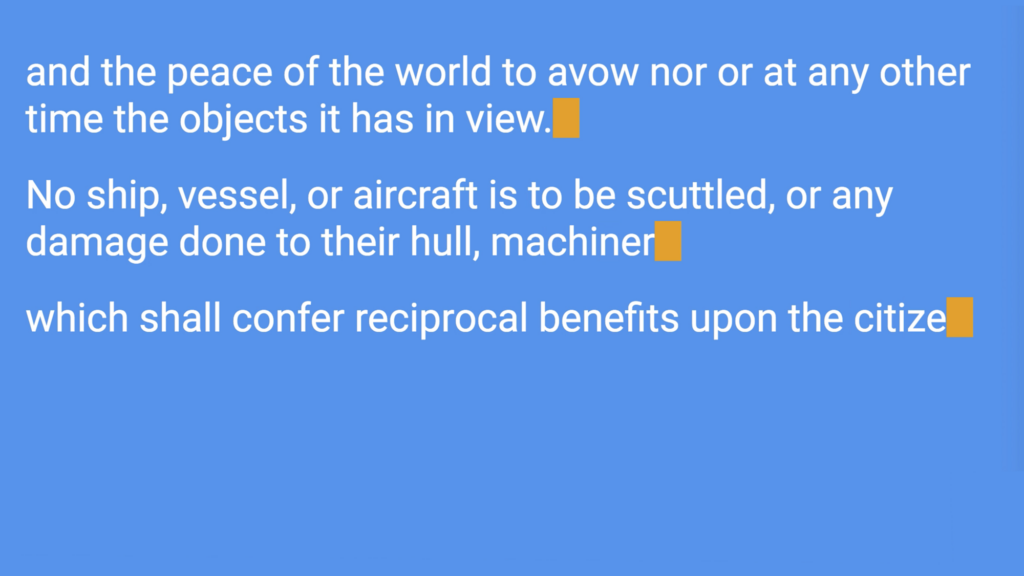The Los Angeles–based music and art collective Lucky Dragons—comprised of Sarah Rara and Luke Fischbeck—has lots of plans for their month-long residency at SFMOMA, titled User Agreement, under way now. Come try to untangle The Tangle, walk The Pattern, or listen to The Problem Solver! All exemplify Lucky Dragons’ clever strategies to engage visitors in creative, often physical forms of problem solving and peace making.
User Agreement is made up of three participatory pieces that will remain on view for the rest of the month, reappearing on weekends and disappearing during the week. The Tangle is a large, tangled mass located just inside the Third Street entrance and made of many different materials such as pool noodles, cables, and rope.

Lucky Dragons, User Agreement, October 2016; photo: Beth LaBerge
The Pattern is a labyrinth for walking meditation located on Floor 2, near the ticket counters. And The Problem Solver is an audio meditation on positive and negative peace—primarily a voice-over narrative, with interwoven field recordings—that people can access at useragreement.sfmoma.org, an online component fed in part by inputs from The Problem Solver and by classroom projects the artists will engage in while they’re in San Francisco.

Lucky Dragons, User Agreement, October 2016; photo: Charles Villyard
“We’re setting things up and leaving them for people to explore and play with in a direct way,” observes Rara. “Whether they realize it or not, they will be enacting two different approaches to peace making: negative and positive. The Tangle in particular is quite difficult, and a bit wild. It has no specific solution.”
Lucky Dragons is perennially interested in unpredictable, emergent systems. Will people be tanglers or untanglers? Will they operate with a shared purpose and goal, or go around undoing each other’s work? “We enjoy observing cooperation, and likewise its absence. The situation will probably change from day to day,” remarks Fischbeck, “and it will always start rather extemporaneously. Rather than following instructions, people will know what to do by observing others.”

Lucky Dragons, User Agreement, October 2016; photo: Charles Villyard
The Problem Solver is for a solitary visitor/listener walking through the galleries, intended to give them space to look and listen both in real time and in what Rara calls “the layered past tense.” She says, “The Problem Solver isn’t specific to SFMOMA’s collection, but rather more open-ended. The voice-over is fairly poetic: mostly questions, some riddles, and philosophical queries that can frame whatever a visitor is looking at or experiencing as they move through the museum.” An excerpt:
Positive peace is not simply the absence of direct violence. It is the absence of both direct and indirect violence,
a position completely free of worry or fear.
if you desire peace, prepare for peace
The rise of soft power
dissolving of hard powerthe radicalist
the gradualist
choose speed of reformwhere begins process of total disarmament
here or then?peace as stillness between conflicts
or
peace as stillnessA description of harmony
A walking peace
Shifting energy of liberation
into energy of building
examine state within
to be peace and build peace
The Problem Solver is the opposite of an audio guide. “There are so many layers of interpretation already in place at a museum—docents, wall texts, audio tours, and the like—so we’re creating an experience that aspires to open things up,” says Fischbeck. “We’re hoping that through the work, people experience viewing itself as problem solving. Creating your own thread. Solving the challenge of engagement, of being a body in space. We believe the opportunity for that kind of new thinking is amplified when one is in the presence of artworks, and especially so in a museum, given the meditative behaviors that are already encouraged there.”
During their residency, Lucky Dragons will create participatory experiences, from a costume-making workshop (which will take place on Free Family Day) to more performative works like I Other Whisper Siren, during which five solitary walkers will appear in the galleries, and one in the White Box. Their performance involves reading and movement—specifically reading a text that the walkers hear via radio and repeat aloud. “The walkers are human microphones, re-broadcasting the text, like how sound is amplified in a protest situation, with people listening and repeating,” says Rara. “Slight translations may occur. For visitors it will be very intimate, as they encounter the individual performers. Even in the White Box it will be an intimate experience, as only a few people will be able to enter at a time. No one will encounter the entire thing from start to finish, but always in fragments, in passing.”
The spoken texts will be drawn from Lucky Dragons’ research in peace studies: writings by Martin Luther King, Mahatma Gandhi, Margaret Mead, Jane Addams, and Henry David Thoreau, historical treaties, United Nations publications, and more. “It will be a collection of different viewpoints,” Fischbeck says, “brought together in a new, original text we’re writing. We’re re-appropriating existing texts as poetry, you could say. For instance one source is a 1960s UN conference on the elimination of statelessness. They were proposing that everyone must be a citizen of some state.”

Lucky Dragons, User Agreement, October 2016
The culminating event, titled User Agreement (same as the month-long project), will involve a large cast of nearly twenty performers wearing the costumes adorned with patches made earlier by visitors. Organized into subgroups, the performers will enact parts of a play that has been workshopped throughout the month, doing their thing in and around the galleries. Visitors can experience the play “out of order” by wandering about the museum, or straightforwardly in the White Box.
According to Rara and Fischbeck, an important underlying question of the whole project relates to tensions between individuals and groups, and the complexities of group membership. A group can be a peacemaking device, since it has a collective voice that can negotiate. Yet it’s also “othering” to be a member of a group, since one must navigate the individual versus the collective, my group versus your group. Is it actually freeing to have allegiance to a group? And how can one achieve peace in the world as it exists, in daily life?